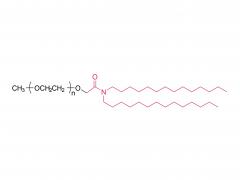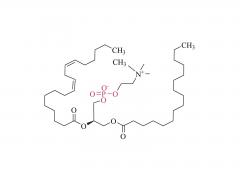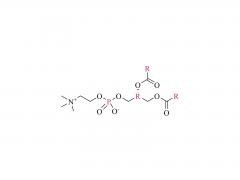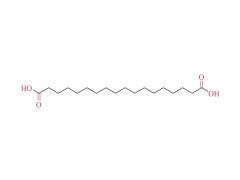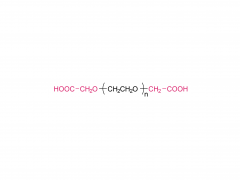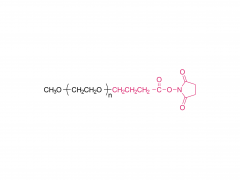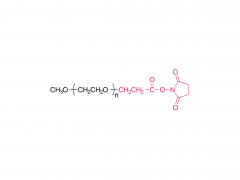1. Methoxy (-OCH₃)
Location: Methoxys are located at the beginning end of mPEG-Alkyne.
Properties: Methoxy is a stable functional group that gives mPEG-Alkyne a certain chemical stability and solubility. The introduction of methoxy at the starting end of the PEG chain prevents further polymerization of the PEG chain and thus controls the molecular weight of the polymer.
2. Alkyne group (-C≡C-)
Location: Alkyne groups are located at the end of mPEG-Alkyne.
High reactivity: alkyne group is a highly reactive functional group that can react with a variety of biomolecules or chemical groups. Such reactions are usually characterized by high efficiency, rapidness and good selectivity, which makes mPEG-Alkyne have wide application prospects in the fields of biological coupling, drug modification and nanomaterials synthesis.
The alkyne group can combine with the azide group (-N₃) through the click chemical reaction to form a stable triazole ring structure. This reaction can be carried out under mild conditions without the need for strict reaction conditions or catalysts, so it is well suited for the modification and synthesis of biomolecules.
3. Polyethylene glycol (PEG) chain
Although the PEG chain itself is not a functional group, it plays a vital role in mPEG-Alkyne. The PEG chain is composed of multiple glycol units (-CH₂-CH₂-O-), giving mPEG-Alkyne good water solubility, biocompatibility, and flexibility. These characteristics make mPEG-Alkyne have wide application value in the field of biomedicine.
4. Application of functional groups
Protein modification: Using the high reactivity of alkynyl groups, mPEG-Alkyne can be combined with azide groups on proteins to achieve peG-modification of proteins. This modification can improve protein stability and biocompatibility and reduce immune responses.
Drug coupling: By clicking chemical reactions, drug molecules can be linked to mPEG-Alkyne to form stable covalent bonds. This can extend the circulation time of the drug in the body, reduce the degradation of the drug, and improve the stability and targeting of the drug.
Nanomaterial modification: mPEG-Alkyne can also be used for surface modification of nanomaterials, binding to azide groups on the surface of nanomaterials through click chemical reactions to form stable modification layers. This could improve the biocompatibility and stability of nanomaterials, allowing them to have wider applications in areas such as bioimaging and drug delivery.
Product technical advantage
SINOPEG offers high quality PEG derivatives with novel and diverse product structures, abundant substituting groups, and high end-group substitution rates.
High PEG functional group content - Content up to 99%
Functionalization of PEG is the most difficult of PEG products. The common problem of the main products on the market is that the functional group content is not high. And we master the modification technology, initiation system, unconventional precipitation method and system extraction method and other technologies and processes can easily produce high functional group content products. The functional group content of most products can reach 99%, which is much higher than the 90% or so of rivals.
High quality PEG molecular weight control -PDI <1.05
The single molecule chain of a polymer is usually composed of many small repeating units connected by polymerization. The design and control of the synthesis method has a crucial influence on the length of a single polymer segment and the similarity of the length of multiple polymer segments. Our PEG synthesis technology guarantees very good dispersion (PDI<1.05), while many other companies' products typically have PDI around 1.1.
Relevant recommendation
|
mPEG-NH2
|
3-arm PEG-OH
|
|
mPEG-CM
|
3-arm PEG-NH2
|
|
mPEG-SA
|
3-arm PEG-CM
|
|
mPEG-SH
|
3-arm PEG-SH
|
|
mPEG-pALD
|
3-arm PEG-SC
|
|
mPEG-MAL
|
3-arm PEG-N3
|
|
mPEG-SC
|
3-arm PEG-NH2·HCl
|
|
mPEG-NPC
|
4-arm PEG-OH
|
|
mPEG-SS
|
4-arm PEG-NH2
|
|
mPEG-N3
|
4-arm PEG-CM
|
|
mPEG-AA
|
4-arm PEG-SA
|
|
mPEG-MA
|
4-arm PEG-SH
|
|
mPEG-VS
|
6-arm PEG-OH
|
|
mPEG-NH2·HCl
|
6-arm PEG-NH2
|
|
2-arm PEG-OH
|
6-arm PEG-CM
|
|
2-arm PEG-COOH
|
6-arm PEG-SA
|
|
2-arm PEG-NHS
|
6-arm PEG-SH
|
|
2-arm PEG-MAL
|
8-arm PEG-NH2
|
|
2-arm PEG-NH2
|
8-arm PEG-CM
|
|
2-arm PEG-Acetal
|
8-arm PEG-SA
|
|
2-arm PEG-CHO
|
8-arm PEG-SH
|
|
2-arm PEG-N3
|
8-arm PEG-pALD
|







